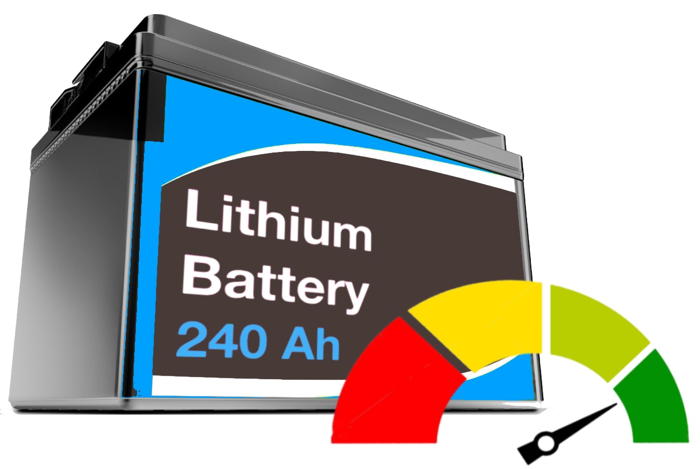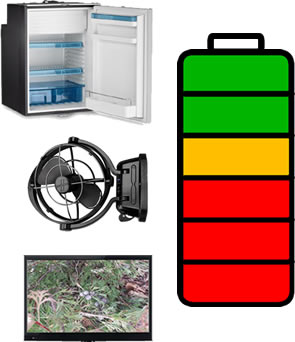Sustainability: Batteries & Solar | Water | Heating
Batteries | Consumption | Battery Recharging | Solar Charging | How Long Without Sun? | Alternate Charging Options | The Bottom Line
How long can we power our 12V appliances, without the availability of the sun to recharge our batteries?
What is our usable battery capacity?
 Our two 120 Ah Lithium batteries shouldn’t be discharged to less than 80% capacity, so the 240 Ah of total battery capacity really equates to a ‘usable’ capacity of 192 Ah. (Discharging below 80% capacity reduces the lifespan of the batteries. Discharging below 10% may require the batteries to be ‘reset’ before recharging.)
Our two 120 Ah Lithium batteries shouldn’t be discharged to less than 80% capacity, so the 240 Ah of total battery capacity really equates to a ‘usable’ capacity of 192 Ah. (Discharging below 80% capacity reduces the lifespan of the batteries. Discharging below 10% may require the batteries to be ‘reset’ before recharging.)
With similar capacity AGM batteries – 2 x 120 Ah- the usable capacity is 120 Ah (50% of total capacity). 50% battery capacity (SoC – State of Charge) of AGM batteries is reached when the voltmeter in the electrical console panel displays 12.1V.
Note 1: SoC is more accurately assessed (for AGM batteries) when there is no load on the battery, and there hasn’t been a load for a couple of hours. With a load on the battery (eg fridge running) the voltage will display as less than the actual SoC, and while it is charging (eg solar panel input) it will display a higher voltage than the actual SoC.
Note 2: The SoC of Lithium batteries cannot be accurately measured by voltage alone. Lithium batteries maintain a relatively ‘flat’ voltage output across their usable 80% capacity (over a 0.5V range), then drop dramatically. A Coulomb Counter is used to measure current input and output to more accurately estimate the battery SoC.
No sun, no solar recharging?
 Photons from sunlight generate current in the solar panel, which is used to recharge the batteries via a DC-DC charger.
Photons from sunlight generate current in the solar panel, which is used to recharge the batteries via a DC-DC charger.
Our solar panel won’t achieve maximum output (or possibly any output) if the sky is cloudy. Or if the van is parked under trees.
Our Redarc DC-DC battery charger is an MPPT charger. MPPT chargers can maximise the use of low power output from the solar panel in early morning and partly cloudy conditions, so we are unlikely to ever have complete zero charging days. Though in challenging conditions the charge rate is likely to be very low.
Appliance consumption v Battery capacity
 In a previous section, we calculated that our appliances consumed about 70Ah of electrical energy per day. Our usable stored battery capacity from our two Lithium batteries is 192Ah.
In a previous section, we calculated that our appliances consumed about 70Ah of electrical energy per day. Our usable stored battery capacity from our two Lithium batteries is 192Ah.
To consider all this in a strictly theoretical context….
If there is complete zero output from the solar panel, and we are powering appliances on nothing other than the stored energy in the two batteries – the usable 192 Ah:
-
- we could be 12V ‘energy sustainable’ for around 3 days, at 70 Ah usage per day. (192 / 70 = 2.7 days).
- with similar capacity AGM batteries, energy sustainability would be around 1.7 days (120 / 70 = 1.7 days).
The fall-back option with no solar charging is to run the vehicle engine to recharge the batteries with current produced by the vehicle alternator. (40 amps per hour, even when idling.)
Maybe a little sunshine?
 Roll out the portable solar mat!
Roll out the portable solar mat!
We have two solar panels – a 150W roof-top panel and a portable 200W solar mat. At maximum capacity in good sunshine these panels could (theoretically) produce a combined 16Ah (6Ah + 10Ah).
With reduced sunlight on the two solar panels, producing a total of (for example) only 6 amps per hour over 6 hours we could produce around 36 Ah per day (6 hours x 6 amps) to feed back into the batteries – which would half-recharge the energy used (70Ah) to power the van’s appliances.
-
- In this case we could be 12 V ‘energy sustainable’ for around 5.5 days at a net 35 Ah per day (100 / 35 = 5.5 days)
- In the case of similar capacity AGM batteries, 12 V ‘energy sustainability’ would be around 3.5 days at a net 35Ah usage per day (120 / 35 = 3.5 days).
Maybe more current would be generated in better conditions, and no doubt less current as the conditions deteriorate.
In the unlikely event that we have no sun at all, we can use the vehicle’s alternator to recharge the batteries.
The next section discusses Alternate Charging Options.
|
See also:
|
Batteries | Consumption | Battery Recharging | Solar Charging | How Long Without Sun? | Alternate Charging Options | The Bottom Line
